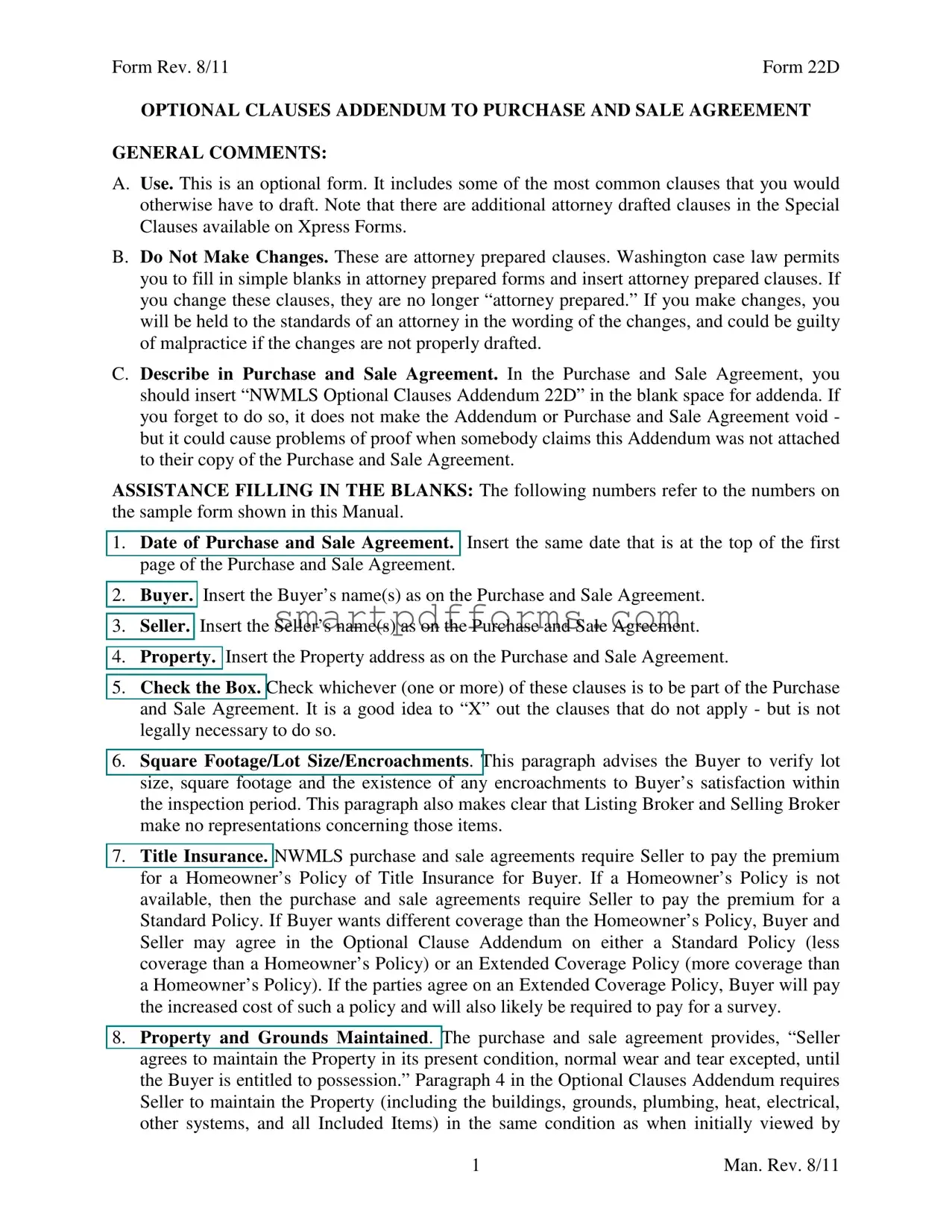OPTIONAL CLAUSES ADDENDUM TO PURCHASE AND SALE AGREEMENT
GENERAL COMMENTS:
A.Use. This is an optional form. It includes some of the most common clauses that you would otherwise have to draft. Note that there are additional attorney drafted clauses in the Special Clauses available on Xpress Forms.
B.Do Not Make Changes. These are attorney prepared clauses. Washington case law permits you to fill in simple blanks in attorney prepared forms and insert attorney prepared clauses. If you change these clauses, they are no longer “attorney prepared.” If you make changes, you will be held to the standards of an attorney in the wording of the changes, and could be guilty of malpractice if the changes are not properly drafted.
C.Describe in Purchase and Sale Agreement. In the Purchase and Sale Agreement, you should insert “NWMLS Optional Clauses Addendum 22D” in the blank space for addenda. If you forget to do so, it does not make the Addendum or Purchase and Sale Agreement void - but it could cause problems of proof when somebody claims this Addendum was not attached to their copy of the Purchase and Sale Agreement.
ASSISTANCE FILLING IN THE BLANKS: The following numbers refer to the numbers on the sample form shown in this Manual.
1.Date of Purchase and Sale Agreement. Insert the same date that is at the top of the first page of the Purchase and Sale Agreement.
2.Buyer. Insert the Buyer’s name(s) as on the Purchase and Sale Agreement.
3.Seller. Insert the Seller’s name(s) as on the Purchase and Sale Agreement.
4.Property. Insert the Property address as on the Purchase and Sale Agreement.
5.Check the Box. Check whichever (one or more) of these clauses is to be part of the Purchase and Sale Agreement. It is a good idea to “X” out the clauses that do not apply - but is not legally necessary to do so.
6.Square Footage/Lot Size/Encroachments. This paragraph advises the Buyer to verify lot size, square footage and the existence of any encroachments to Buyer’s satisfaction within the inspection period. This paragraph also makes clear that Listing Broker and Selling Broker make no representations concerning those items.
7.Title Insurance. NWMLS purchase and sale agreements require Seller to pay the premium for a Homeowner’s Policy of Title Insurance for Buyer. If a Homeowner’s Policy is not available, then the purchase and sale agreements require Seller to pay the premium for a Standard Policy. If Buyer wants different coverage than the Homeowner’s Policy, Buyer and Seller may agree in the Optional Clause Addendum on either a Standard Policy (less coverage than a Homeowner’s Policy) or an Extended Coverage Policy (more coverage than a Homeowner’s Policy). If the parties agree on an Extended Coverage Policy, Buyer will pay the increased cost of such a policy and will also likely be required to pay for a survey.
8.Property and Grounds Maintained. The purchase and sale agreement provides, “Seller agrees to maintain the Property in its present condition, normal wear and tear excepted, until the Buyer is entitled to possession.” Paragraph 4 in the Optional Clauses Addendum requires Seller to maintain the Property (including the buildings, grounds, plumbing, heat, electrical, other systems, and all Included Items) in the same condition as when initially viewed by
Form Rev. 8/11Form 22D
OPTIONAL CLAUSES ADDENDUM TO PURCHASE AND SALE AGREEMENT
Buyer. In addition, the paragraph requires Seller to repair or replace appliances that malfunction during prior to the transfer of possession.
9.Items Left by Seller. This paragraph makes clear that all items left by Seller become the property of Buyer and requires Seller to clean the Property prior to Buyer taking possession.
10.Utilities. Check the box to indicate if Seller is representing that the Property is connected to the described utilities.
11.Insulation - New Construction. If the house is new construction, Federal Trade Com- mission rules require that this information be filled in. If there is no wall and/or ceiling insulation, then fill in “none” or “no insulation” following “Type.” Leaving it blank could mean it was ignored or not explained to the parties.
12.Leased Property. Use this clause if the Seller leases personal property that will pass to the Buyer on Closing. By selecting this clause, the Buyer agrees to assume the lease and will be solely responsible for any breach of the lease, including failure to pay. The Buyer should obtain and review all leases before agreeing to assume them.
13.Homeowners’ Association Review Period. Use this clause if the Property is subject to a homeowners’ association and the Buyer wants to review the documents listed in Form 22D as a condition to purchasing the Property. Fill in the number of days that the Seller has to provide the documents listed in this paragraph (if available), and also fill in the number of days that the Buyer has to review the documents. Note that the burden is on the Buyer to give the notice of disapproval within the prescribed time period if Buyer does not approve the documents and elects to terminate the transaction. Otherwise, the homeowner’s association review condition will waive automatically, and Buyer will no longer have the right to terminate the contract on this basis.
14.Excluded Items. Use this clause if there are any items that the parties would like to exclude from the sale, which would otherwise be included in the sale. The items that are included in the sale are listed in General Term “c” of the Purchase and Sale Agreement.
15.E-mail Transmission. Use this clause if the parties elect to allow for the e-mail delivery of transaction documents. If the buyer and the seller agree, the e-mail transmission and retransmission of any signed original document is the same as the delivery of the original. This includes the delivery of all transaction documents, including the acceptance of offers and counteroffers, rescissions, notices, seller disclosure statements, resale certificates, preliminary commitment for title insurance, etc.
Form 22D contains a field for e-mail addresses for the Selling Broker, Selling Firm, Listing Broker, and Listing Firm. For delivery to be effective, the document must be sent to both the Selling Broker and Selling Firm or the Listing Broker and Listing Firm. The Firm e-mail address on Form 22D is the “Listing Firm Authorized E-mail Address” or the “Selling Firm Authorized E-mail Address.” Each firm must determine which e-mail address to use for the “Firm Authorized E-mail Address” and make sure the firm’s brokers use that e-mail address on the form.
If the document is sent to both the applicable e-mail addresses identified in Form 22D, then delivery is effective. The party receiving the e-mail does not have to acknowledge receipt of the e-mail for delivery to be effective.
OPTIONAL CLAUSES ADDENDUM TO PURCHASE AND SALE AGREEMENT
16.Other. You can use this space to include other special clauses. You can also use the blank Addendum Form No. 34. If you use Form 34, you are advised to use the attorney drafted “Special Clauses” in the front of this Manual.
17.Initials and Date. Buyer(s) and Seller(s) should initial and date this Addendum. Insert the date each person initialed, not the date on the Purchase and Sale Agreement.

Form 22D |
|
©Copyright 2011 |
Optional Clauses Addendum |
|
Northwest Multiple Listing Service |
Rev. 8/11 |
OPTIONAL CLAUSES ADDENDUM TO |
ALL RIGHTS RESERVED |
Page 1 of 2 |
|
PURCHASE & SALE AGREEMENT |
|
|
|
The following is part of the Purchase and Sale Agreement dated |
|
|
|
|
1 |
|
|
1 |
__________________________________________ |
|
|
|
|
|
|
|
|
|
|
|
|
|
|
between |
|
|
|
|
|
|
2 |
|
|
|
(“Buyer”) |
2 |
|
|
|
|
|
|
|
|
|
|
|
|
|
and |
|
|
|
|
3 |
|
|
|
|
|
(“Seller”) |
3 |
|
|
|
|
|
4 |
concerning ________________________________________________________________________ (the "Property”). |
|
4 |
|
|
|
|
|
|
|
|
|
|
|
|
|
|
|
|
|
|
|
|
|
|
CHECK IF INCLUDED: |
5 |
|
|
|
|
|
|
|
|
|
|
5 |
1. Square Footage/Lot Size/Encroachments. The Listing Broker and Selling Broker make no representations |
6 |
concerning: (a) the lot size or the accuracy of any information provided by the Seller; (b) the square footage of |
7 |
any improvements on the Property; (c) whether there are any encroachments (fences, rockeries, buildings) on |
8 |
the Property, or by the Property on adjacent properties. Buyer is advised to verify lot size, square footage and |
9 |
encroachments to Buyer’s own satisfaction within the inspection contingency period. |
|
10 |
2.Title Insurance. The Title Insurance clause in the Agreement provides Seller is to provide the then-current ALTA 11
form of Homeowner’s Policy of Title Insurance. The parties have the option to provide less coverage by selecting 12
a Standard Owner’s Policy or more coverage by selecting an Extended Coverage Policy: |
13 |
7 |
Standard Owner’s Policy. Seller authorizes Buyer’s lender or Closing Agent, at Seller’s expense, to 14 |
|
apply for the then-current ALTA form of Owner’s Policy of Title Insurance, together with homeowner’s 15 |
|
additional protection and inflation protection endorsements, if available at no additional cost, rather than 16 |
|
the Homeowner’s Policy of Title Insurance. |
17 |
|
|
7 |
Extended Policy. Seller authorizes Buyer’s lender or Closing Agent, at Seller’s expense to apply for an 18 |
|
ALTA or comparable Extended Coverage Policy of Title Insurance, rather than the Homeowner’s Policy 19 |
|
of Title Insurance. Buyer shall pay the increased costs associated with the Extended Coverage Policy, 20 |
|
including the excess premium over that charged for Homeowner’s Policy of Title Insurance and the cost 21 |
|
of any survey required by the title insurer. |
22 |
3. Property And Grounds Maintained. Until possession is transferred to Buyer, Seller agrees to maintain the 23 Property in the same condition as when initially viewed by Buyer. The term “Property” includes the building(s); 24 grounds; plumbing, heat, electrical and other systems; and all Included Items. Should an appliance or system 25 become inoperative or malfunction prior to transfer of possession, Seller agrees to either repair, or replace the 26 same with an appliance or system of at least equal quality. Buyer reserves the right to reinspect the Property 27 within 5 days prior to transfer of possession to verify the foregoing. Buyer and Seller understand and agree 28
that the Listing Broker and Selling Broker shall not, under any circumstances, be liable for the foregoing or 29
Seller’s breach of this clause. |
30 |
4. Items Left by Seller. Any personal property, fixtures or other items remaining on the Property when 31 possession is transferred to Buyer shall thereupon become the property of the Buyer, and may be retained or 32
disposed of as Buyer determines. However, Seller agrees to clean the interiors of any structures and remove 33
all trash, debris and rubbish on the Property prior to Buyer taking possession. |
34 |
5. Utilities. To the best of Seller's knowledge, Seller represents that the Property is connected to a: |
35 |
public water main; public sewer main; septic tank; well (specify type) _______________________ ; 36
irrigation water (specify provider) ___________________________________; natural gas; telephone; 37
cable; electricity; other ______________________________________________________________ . 38
Date: _____________ SELLER:
BUYER: _________________ Date: _____________ SELLER: ________________ Date: ___________


